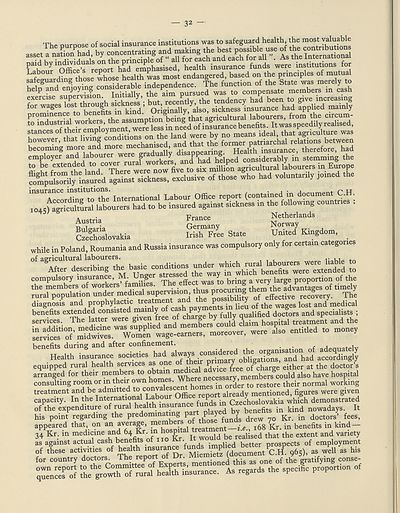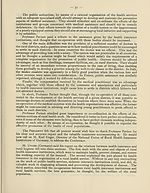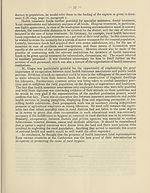Download files
Complete book:
Individual page:
Thumbnail gallery: Grid view | List view

— 32 —
The nuroose of social insurance institutions was to safeguard health, the most valuable
^he^thhi™uruwe'fuods were inslituuons for
^ ■ -1 ^ . ? Tnitiallv the aim pursued was to compensate members in cash
for w^gesy^sTtlrtfough sickness ; b«; ^kSnsuraoce^hld ffplied0Sy
mmsm
“ F-rn“ Noe™ayandS
Czechoslovakia Wsh FrL State United Kingdom,
while in Poland, Roumania and Russia insurance was compulsory only for certain categories
°f ^ARer^iribinTI ^ “ndiuons - ^t^UnS wlrl^te'S Z
»™. Tl„ latte, wet. ^ 3““ pM Je.tmeS. aal .1.
benefits during and after confinement.
Health insurance societies had alway^^ afcS^y
equipped rural health services as on , ^ • free 0f charge either at the doctor’s
arranged for their members t° "where necessary, members could also have hospital
consulting room or in their own horn . i • orcier to restore their normal working
treatment and be admitted to convalesced ho^ figures were given
capacity. In the International La our f ^ds in Czechoslovakia which demonstrated
of the expenditure of rural health insurance tunas in , fits in kind nowadays. It
his point regarding the predominating pa P Y drew Kr in doctors’ fees,
appeared that, on an average, membe trri(ant ie 168 Kr in benefits in kind —
34 Kr. in medicine ^ 3 It" would be realised that'the extent and variety
as against actual cash benefits or no • - i- j u^tter orosnects of employment
","1 X,‘gVSr?™t,°l b,2f i—r's. t.g.Td. th. ptoportion c,
The nuroose of social insurance institutions was to safeguard health, the most valuable
^he^thhi™uruwe'fuods were inslituuons for
^ ■ -1 ^ . ? Tnitiallv the aim pursued was to compensate members in cash
for w^gesy^sTtlrtfough sickness ; b«; ^kSnsuraoce^hld ffplied0Sy
mmsm
“ F-rn“ Noe™ayandS
Czechoslovakia Wsh FrL State United Kingdom,
while in Poland, Roumania and Russia insurance was compulsory only for certain categories
°f ^ARer^iribinTI ^ “ndiuons - ^t^UnS wlrl^te'S Z
»™. Tl„ latte, wet. ^ 3““ pM Je.tmeS. aal .1.
benefits during and after confinement.
Health insurance societies had alway^^ afcS^y
equipped rural health services as on , ^ • free 0f charge either at the doctor’s
arranged for their members t° "where necessary, members could also have hospital
consulting room or in their own horn . i • orcier to restore their normal working
treatment and be admitted to convalesced ho^ figures were given
capacity. In the International La our f ^ds in Czechoslovakia which demonstrated
of the expenditure of rural health insurance tunas in , fits in kind nowadays. It
his point regarding the predominating pa P Y drew Kr in doctors’ fees,
appeared that, on an average, membe trri(ant ie 168 Kr in benefits in kind —
34 Kr. in medicine ^ 3 It" would be realised that'the extent and variety
as against actual cash benefits or no • - i- j u^tter orosnects of employment
","1 X,‘gVSr?™t,°l b,2f i—r's. t.g.Td. th. ptoportion c,
Set display mode to:
![]() Universal Viewer |
Universal Viewer | ![]() Mirador |
Large image | Transcription
Mirador |
Large image | Transcription
Images and transcriptions on this page, including medium image downloads, may be used under the Creative Commons Attribution 4.0 International Licence unless otherwise stated. ![]()
| League of Nations > Health > European conference on rural hygiene (June 29th-July 7th, 1931) > (34) |
|---|
| Permanent URL | https://digital.nls.uk/190662279 |
|---|
| Shelfmark | LN.III |
|---|---|
| Description | Over 1,200 documents from the non-political organs of the League of Nations that dealt with health, disarmament, economic and financial matters for the duration of the League (1919-1945). Also online are statistical bulletins, essential facts, and an overview of the League by the first Secretary General, Sir Eric Drummond. These items are part of the Official Publications collection at the National Library of Scotland. |
|---|---|
| Additional NLS resources: |
|

